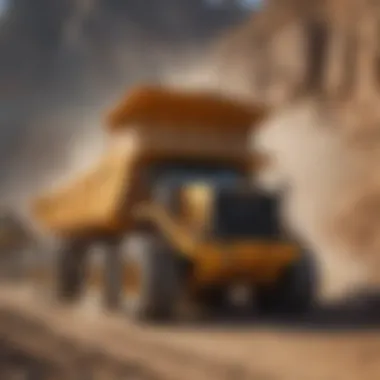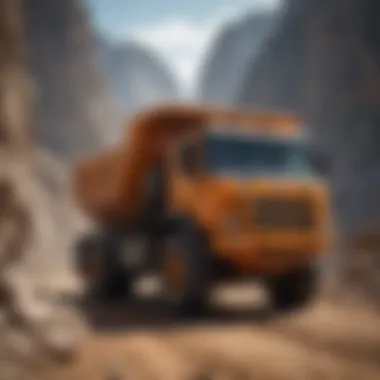Articulated Rock Trucks: Overview & Insights


Intro
Articulated rock trucks represent a significant evolution in the transportation of heavy materials, particularly in industries like construction and agriculture. Their unique design allows for greater maneuverability and load capacity compared to traditional rigid trucks. As professionals in these fields seek efficiency and effectiveness, understanding articulated rock trucks becomes imperative.
These vehicles are not merely tools; they are pivotal in optimizing operations. From moving earth to transporting harvested crops, articulated rock trucks perform a range of functions. Their engineering exemplifies innovation, blending power with adaptability. This article will explore their design, functionality, applications, maintenance, safety, and environmental factors, providing readers with a well-rounded perspective on articulated rock trucks.
Key Concepts and Terminology
Basic Definitions
Articulated rock trucks consist of two parts: a front cab connected to a rear dump body. This design allows for shorter turning radii and improved handling on uneven terrain. The articulated joint provides flexibility, enabling the truck to navigate tight spaces better than traditional models. A few terminologies to note include:
- Payload: The total weight the truck can carry, significantly higher in articulated models.
- Articulation Point: The pivoting joint between the cab and the dump body, crucial for movement.
Historical Context
The concept of articulated vehicles dates back to the 20th century, but these trucks have evolved significantly over time. Early models were basic and lacked features that enhance efficiency. Over the decades, advancements in hydraulic systems, materials, and safety standards have transformed articulated rock trucks into sophisticated machines. The need for more efficient material transport spurred these developments, aligning with the growing demands of the agriculture and construction sectors.
Recent Innovations and Trends
Technological Advancements
Today, articulated rock trucks integrate various technological innovations. For instance, systems like telematics monitor vehicle performance in real-time, aiding in maintenance and operational efficiency. These advancements ensure that drivers have access to crucial data about load weight, fuel consumption, and maintenance needs directly from their control panels, allowing for better decision-making.
Sustainable Practices
Sustainability remains a pivotal concern within industries. Modern articulated rock trucks now feature more fuel-efficient engines and electrification options. These changes reduce carbon footprints and operational costs, aligning with global efforts to promote eco-friendly practices. Companies are increasingly focused on not just meeting regulations but exceeding them as they adapt to a changing environment.
Practical Applications and Techniques
Step-by-step Guides
Utilizing articulated rock trucks in agriculture or construction requires understanding their features and capabilities. To maximize efficiency:
- Assess Load Requirements: Determine the weight and volume of materials to ensure compliance with truck payload limits.
- Train Operators: Ensure all drivers are trained in handling articulated trucks, emphasizing safety and operational methods.
- Regular Maintenance: Schedule routine checks to keep the vehicles running smoothly. Issues like tire pressure and fluid levels should be routinely monitored.
Case Studies
Several industries have effectively integrated articulated rock trucks into their operations. One notable example includes a Wisconsin-based construction firm that adopted these trucks to reduce downtime during material transport. By switching to articulated models, they improved delivery speed and enhanced site productivity. This adaptation not only increased efficiency but also reduced the need for additional equipment, illustrating the financial benefits of these trucks.
"Articulated trucks have redefined how materials move in challenging terrains, making them indispensable in modern operations."
In summary, articulated rock trucks are more than impressive pieces of machinery. They represent innovation and efficiency across agriculture and construction sectors, warranting further exploration of their capabilities and impacts.
Understanding Articulated Rock Trucks
Articulated rock trucks are a crucial component of heavy equipment in various industries. Their unique design and functionality enhance efficiency in transporting massive loads across challenging terrains. Understanding articulated rock trucks involves exploring their definition, purpose, and historical context. This knowledge is essential for professionals in agriculture and construction who rely on these vehicles for their operations.
Definition and Purpose
Articulated rock trucks, also known as articulated dump trucks, are designed for transporting loose materials like dirt, gravel, and rocks. They consist of two main sections: the front cab, which contains the driver and the engine, and the rear dump body where materials are loaded. The articulation joint allows the rear section to pivot, providing superior maneuverability in tight spaces.
The primary purpose of articulated rock trucks is to facilitate the transportation of bulk materials over uneven and rugged terrain. Their ability to navigate in confined environments makes them ideal for construction sites, agricultural fields, and mining operations. They are especially useful where traditional rigid trucks would struggle.
Historical Development of Articulated Trucks


The development of articulated trucks dates back to the mid-20th century, in response to the growing demand for effective transportation solutions in construction and agriculture. The first articulated dump truck was created in the 1980s as engineers aimed to overcome the limitations of conventional trucks. It allowed operators to manage larger payloads while accessing remote locations. Over the years, several manufacturers improved designs, introducing features such as enhanced traction control and advanced hydraulic systems.
The ongoing advancements reflect a broader trend towards automation and improved safety standards. As industries evolve, articulated rock trucks continue to adapt, integrating new technologies to enhance their capabilities and maintain relevance in modern operations.
Design Features of Articulated Rock Trucks
Articulated rock trucks are distinguished by their unique design features that cater specifically to the demands of heavy-duty transport in challenging environments. Understanding these elements is crucial for those involved in industries like agriculture and construction, as the efficiency and adaptability of these vehicles hinge on their engineering principles.
Articulation Mechanism
The articulation mechanism is the defining characteristic of articulated rock trucks. Unlike traditional rigid-frame trucks, articulated trucks have a flexible hinge between the cab and the trailer. This feature allows the truck to navigate tight corners and uneven terrains with ease. The truck's ability to pivot at the joint reduces strain on the frame and ensures better stability, especially when hauling heavy loads. This design significantly enhances maneuverability in confined spaces like construction sites or orchards.
Moreover, the articulation mechanism contributes to the stability of the load during transportation. The independent movement of the front and rear sections allows the truck to maintain a steady balance, preventing spills and ensuring the safety of both the operator and the cargo. This aspect is particularly relevant in agricultural and mining operations, where fluctuations in terrain can impact transport efficiency.
Load Capacity and Dimensions
Another critical factor is the load capacity and dimensions of articulated rock trucks. These trucks are designed to transport substantial weight, typically ranging from 20 to 40 tons, depending on the model. The dimensions of the truck are optimized to accommodate various loads while maintaining stability.
For instance, the broad base of the truck combined with a low center of gravity ensures it can handle heavy loads without tipping. This feature is essential for farmers requiring reliable transport for materials like soil, gravel, or livestock feed. It is also applicable in construction, where bulk materials are needed on-site.
Additionally, the size of the truck allows it to traverse over surfaces that would otherwise be inaccessible to larger vehicles. This adaptability is vital in agricultural fields that may have limited access due to waterlogged conditions or uneven terrains.
Engine and Power Systems
The engine and power systems of articulated rock trucks play a pivotal role in their performance. Typically equipped with robust diesel engines, these trucks are built to handle the demanding conditions of construction and agricultural sites. The power output usually ranges from 200 to 400 horsepower, allowing for optimal performance in transporting heavy loads across various landscapes.
Power systems included in articulated trucks focus on efficiency and fuel conservation. Many modern trucks now feature advanced engine technologies that reduce emissions without compromising power output. This is increasingly important in today’s environment-conscious industry standards.
Furthermore, articulated rock trucks often come with all-wheel drive capabilities. This ensures that power is distributed effectively, providing superior traction on slippery or steep terrains. The coupling of powerful engines with advanced traction systems means that they can operate efficiently in diverse conditions, ensuring productivity for agricultural workers and construction teams alike.
The careful design of articulated rock trucks not only enhances performance but also contributes to increased safety and operational efficiency in heavy-duty transport.
In summary, the design features of articulated rock trucks are integral to their functionality. The articulation mechanism enhances maneuverability, while appropriate load capacities ensure safe transport. Robust engine systems provide the necessary power to navigate varied environments efficiently. Understanding these features is essential for users to maximize the utility of articulated rock trucks in their respective fields.
Applications of Articulated Rock Trucks
Articulated rock trucks have a significant role in various industries, primarily construction, agriculture, and mining. These robust vehicles are tailored for transporting heavy materials across uneven terrains. Their versatility allows for reliable performance in demanding jobs. The following sections explore specific applications of articulated rock trucks, underlining their importance and benefits.
Construction Industry Utilization
In the construction sector, articulated rock trucks serve a crucial purpose. They are essential for earthmoving, material transport, and site preparation. Projects often require moving large quantities of soil, gravel, or demolition debris. Articulated rock trucks can easily navigate rough terrain, making them ideal for site conditions that other vehicles struggle with.
One notable advantage is their ability to perform effectively on limited access sites. Their design permits tight maneuvering spaces without disrupting surrounding areas. Moreover, these trucks have high load capacities, contributing to efficient material movement. Less trips are needed, which saves time in project schedules.
Some examples of construction uses include:
- Transporting aggregates to mixing locations.
- Moving excavated materials to designated dumping sites.
- Assisting in backfilling and grading operations.
Agricultural Implementations
Articulated rock trucks have also found their niche in agriculture. Their utility extends beyond traditional farming machinery, particularly in larger operations. They provide effective transport for bulk materials like fertilizers, feed, and crops.
Farmers benefit from the flexibility of articulated rock trucks. With challenging weather conditions or rough fields, these trucks can maintain performance. Their capacity to manage heavy loads while traversing uneven surfaces makes them invaluable in agricultural contexts.
Key applications in agriculture include:


- Transporting harvested crops from fields to processing areas.
- Distributing soil amendments across various terrains.
- Hauling heavy equipment or supplies between farm locations.
Mining Operations
In mining operations, articulated rock trucks are indispensable. The rugged and variable terrain is commonplace in mining sites. These trucks can handle the weight and size of mined materials efficiently. Their design allows for excellent weight distribution, reducing soil compaction, which is vital for protecting the site environment.
Articulated rock trucks enhance productivity in mining companies. They can transport ore from extraction points to processing facilities with reduced downtime. The ability to navigate tight spaces is particularly useful in underground or open-pit mining scenarios.
Mining applications encompass:
- Moving ore from extraction zones to crushing sites.
- Transporting waste rock away from operational areas.
- Facilitating site reclamation efforts post-extraction.
"Articulated rock trucks are essential tools in enhancing operational efficiency across various sectors, providing a mix of power and precision."
This combination of applications illustrates the vital role articulated rock trucks play across key industries. Their adaptability ensures they remain competitive and crucial in modern operations.
Benefits of Articulated Rock Trucks
Articulated rock trucks offer distinct advantages, making them invaluable in various industries, especially agriculture and construction. Understanding these benefits helps in appreciating their role in enhancing productivity and efficiency. Each benefit addresses specific operational needs and challenges, showcasing why articulated rock trucks are preferred over traditional trucks in certain contexts.
Enhanced Mobility and Maneuverability
One of the standout features of articulated rock trucks is their enhanced mobility and maneuverability. These trucks have a flexible joint between the cab and the trailer, allowing them to navigate tight spaces and uneven terrain. This is essential in environments like construction sites, where space is often limited, or in agricultural fields, where terrain can be unpredictable.
"Mobility is crucial. In construction and agriculture, the ability to move easily affects productivity."
The articulation allows for better weight distribution, reducing the risk of tipping over. This design aspect is particularly beneficial when operating on slopes or soft ground, enabling the truck to function where rigid trucks might fail.
Operational Efficiency
Beyond mobility, articulated rock trucks significantly enhance operational efficiency. Their design accommodates larger loads compared to standard dump trucks, which means fewer trips required to move the same amount of material. This efficiency translates into lower labor costs and reduced fuel consumption, yielding a more profitable operation.
Key points of operational efficiency include:
- High load capacity permits transportation of bulk materials.
- The ability to traverse difficult terrains minimize downtime due to equipment failure.
- Improved cycle times result from faster loading and unloading phases.
In construction sectors, this efficiency can lead to quicker project completions. For agricultural workers, it means the capacity to manage farm operations with less machinery, increasing overall productivity.
Safety Improvements
Safety is a crucial consideration in any heavy machinery usage, and articulated rock trucks boast several design features that enhance safety improvements. The low center of gravity, achieved by the design of these trucks, coupled with their articulation, provides better stability during both operation and transport.
In addition to this structural safety, articulated rock trucks often come equipped with advanced safety technologies, such as:
- Rollover protection systems that minimize the risk of accidents in challenging conditions.
- Advanced braking systems that provide greater control when operating on inclines or rough terrain.
- Visibility enhancements through strategically placed mirror and camera systems which help operators see obstacles clearly.
These safety features reduce potential injury risks and damages, making articulated rock trucks a wise choice for industries demanding high safety standards.
Challenges and Considerations
When working with articulated rock trucks, it is crucial to recognize various challenges and considerations that impact their efficiency and operations. Understanding these aspects can enhance decision-making for agriculture farmers and enthusiasts. This section focuses on three primary areas: maintenance requirements, environmental impact, and operational costs.
Maintenance Requirements
Maintaining articulated rock trucks is essential for ensuring their enduring performance and reliability. Regular maintenance checks can prevent equipment failure and extend the life of the vehicle. Common maintenance tasks include:


- Regular oil changes to keep the engine in optimal condition
- Checking hydraulic systems for leaks, as they can lead to costly repairs
- Inspecting tire conditions and ensuring proper air pressure for stability and efficiency
- Routine brake inspections to guarantee safety during operations
Failing to adhere to these maintenance needs can result in unexpected downtime, leading to decreased productivity. Moreover, maintaining an articulated rock truck requires skilled personnel who understand the intricacies of these machines. Therefore, it is crucial for operators to educate themselves on best practices for ongoing maintenance.
Environmental Impact
The environmental considerations associated with articulated rock trucks are becoming increasingly prominent. These vehicles, while effective, contribute to emissions and operational noise that can affect local ecosystems. Some key points regarding their environmental impact include:
- Emissions: Articulated rock trucks often run on diesel engines, emitting pollutants that can harm air quality. Utilizing newer models equipped with cleaner technologies can help mitigate this effect.
- Soil Disturbance: Heavy construction and agricultural vehicles can compact soil and disrupt habitats. Optimal usage and routing can minimize this impact and promote sustainable practices.
Addressing these issues calls for the industry to adapt and implement technologies that reduce emissions and noise levels. When the equipment minimizes its ecological footprint, it contributes positively to the community and regulatory compliance.
Operational Costs
Understanding the operational costs involved with articulated rock trucks is essential for making informed investment decisions. The expenses can vary based on several factors such as:
- Fuel Consumption: These trucks typically consume more fuel than standard vehicles due to their size. Efficient driving practices can help reduce fuel expenses.
- Maintenance Costs: The costs associated with regular maintenance and repairs must be factored into the overall operational budget. Ignoring maintenance can lead to more expensive repairs down the line.
- Insurance and Licensing: An often-overlooked aspect, insurance premiums can vary based on the equipment's use and risk factors that come with operating heavy machinery.
Understanding the total operational costs helps in budgeting and planning for the life of the truck. Proper financial management ensures sustained operation and minimizes the risk of unexpected expenses.
Future Trends in Articulated Rock Truck Technology
As industries seek more efficient ways to minimize costs and maximize productivity, the evolution of articulated rock trucks becomes increasingly significant. In recent years, technology advancements have greatly impacted the design and functionality of these vehicles, allowing for new capabilities and improved performance. Understanding these future trends is essential for agricultural farmers and industry enthusiasts.
Advancements in Automation
Automation is becoming a dominant trend in articulated rock truck technology. The integration of autonomous systems enhances operational efficiency and eliminates human error. Technologies such as GPS, remote sensing, and machine learning are optimizing route planning and payload management. This not only minimizes fuel consumption but also reduces wear and tear on equipment.
- Automated Driving Systems: Many manufacturers are investing in automated driving systems, allowing articulated rock trucks to operate with minimal human intervention. This technology is still in its infancy but shows promise in reducing labor costs.
- Data Analytics: Advanced analytics platforms are used to gather real-time data on vehicle performance and operational metrics. This feedback allows for timely maintenance and reduces downtime.
- Safety Enhancements: With automation, the risk of accidents can be significantly lowered. Autonomous systems will constantly monitor the environment, detecting obstacles and adjusting routes as necessary.
Investing in automation may require significant upfront capital, but the long-term savings on labor and maintenance costs can justify the expenditure.
Sustainability Initiatives
Sustainability is now at the forefront of advancements within articulated rock truck technology. As environmental concerns grow, manufacturers are focusing on eco-friendly designs and practices. These initiatives are not only beneficial for the planet but also align with the increasing demand for green practices in agriculture and construction.
- Alternative Fuel Sources: The transition from diesel to alternative fuel options, such as electric or hybrid systems, reduces carbon emissions. Electric articulated rock trucks are gaining traction in urban environments where emissions regulations are stringent.
- Recyclable Materials: Manufacturers are increasingly utilizing recyclable and sustainable materials in the production of these trucks, reducing waste and the overall environmental impact.
- Energy Efficiency: Innovations aimed at improving fuel efficiency can lead to significant reductions in operational costs while helping to conserve resources.
The drive toward sustainability reflects a broader trend across industries. Investing in articulated rock trucks that prioritize eco-friendly practices may not only fulfill regulatory requirements but also meet consumers' growing demand for sustainability.
The End
Articulated rock trucks are essential vehicles in various industries, particularly in agriculture and construction. Their sophisticated design and innovative engineering allow for superior performance compared to conventional dumper trucks. The conclusion of this piece synthesizes key insights regarding the importance, benefits, and future potential of these vehicles.
Summary of Key Points
- Definition and Purpose: Articulated rock trucks are designed specifically for transporting heavy loads across rough terrain. Their unique articulation mechanism enhances maneuverability, making them suited for complex work environments.
- Design Features: The trucks boast robust load capacities and powerful engines. These characteristics ensure that they can handle demanding tasks efficiently.
- Applications: Their use spans multiple sectors, including agriculture for transporting soil and crops, and construction for carrying materials on-site.
- Benefits: The advantages observed include improved mobility, operational efficiency, and enhanced safety measures. Each aspect contributes significantly to their cost-effectiveness over time.
- Challenges: Although beneficial, articulated trucks require regular maintenance and can exhibit considerable environmental impact, demanding a mindful approach from operators.
- Future Trends: The future of articulated rock trucks seems promising, with advancements in automation and a push for sustainability initiatives shaping their design and functionality in upcoming years.
The Role of Articulated Rock Trucks in Future Industries
As industries advance, articulated rock trucks will become even more pivotal. Their ability to adapt to new technologies, particularly automation, will redefine operational processes. The integration of advanced systems could enhance their efficiency and effectiveness in transporting loads.
Moreover, the focus on sustainability in various industries aligns with the capabilities of these trucks. Utilizing eco-friendly engines and technologies can lessen their environmental footprint, making them a choice for companies aiming to meet regulatory standards and consumer expectations.
In summary, articulated rock trucks will likely retain a vital position in agriculture and construction. Their continued evolution will reflect the changing needs of the industry, reinforcing their relevance for the future.
"The future of articulated rock trucks is not just about being able to move loads; it is also about moving towards sustainability and efficiency."
For further reading:















